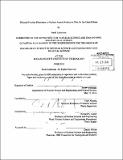Minimal nuclear deterrence : a nuclear arsenal reduction plan for the United States
Author(s)
Laderman, Sarah (Sarah Jane)
DownloadFull printable version (3.958Mb)
Alternative title
Nuclear arsenal reduction plan for the United States
Other Contributors
Massachusetts Institute of Technology. Dept. of Nuclear Science and Engineering.
Advisor
Vipin Narang.
Terms of use
Metadata
Show full item recordAbstract
The global political climate has called for reductions to nuclear arsenals around the world. This thesis researches how potential deep cuts to the United States' large strategic nuclear arsenal would affect its current nuclear deterrence goals. First, case studies on pre-1960 United States, 1964-2012 France, and 1964-2012 China are conducted to understand how a small nuclear arsenal should be constructed in order to prevent nuclear attack from countries with large nuclear arsenals. The lessons learned from these case studies, the current United States deterrence requirements, and the destructive effects from different warheads are then used to propose a potential composition of a small nuclear arsenal for the United States. The proposal consists of only around 500 warheads (in comparison to the current 2,000 the US has on deployment) and achieves United States deterrence goals through its vast destructive capability, variability, and survivability if targeted against in a first nuclear strike.
Description
Thesis (S.B.)--Massachusetts Institute of Technology, Dept. of Nuclear Science and Engineering, 2012. "June 2012." Cataloged from PDF version of thesis. Includes bibliographical references (p. 39-40).
Date issued
2012Department
Massachusetts Institute of Technology. Department of Nuclear Science and EngineeringPublisher
Massachusetts Institute of Technology
Keywords
Nuclear Science and Engineering.